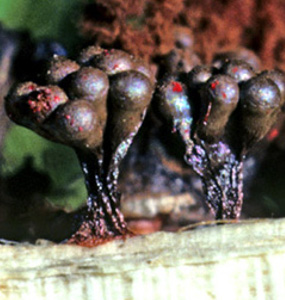Metatrichia vesparia

Image Courtesy of Henry H. Mashburn
| Click to Enlarge |
| Click For Image Gallery |
|
Group of Fungi: Slime Molds Family: Trichiaceae Latin Name: Metatrichia vesparia (Batsch) Nann.-Bremek. ex G.W.Martin & Alexop. Common Name: Wasp's Nest Slime Mold Description: Multi-headed structure (with each of the "heads" looking like a tiny goblet when the spores have been lost) sharing a common stalk, 1/16–1/8 in (0.15–0.3 cm) tall and up to 1/16 in (0.15 cm) wide, usually occurring in small clusters, wine-red to dark maroon or sometimes nearly black; stalk 1/32–1/16 (0.1–0.15 cm) long, brick red in color; spore-bearing surface lacking; spores brownish red in mass. Biological Role: The vegetative stage (called a plasmodium) in the life cycle of this organism feeds upon the bacteria associated with decaying plant material. Habitat: On decaying wood or bark in broadleaf or conifer forests. Geographical Distribution: Found throughout North America and other regions of the Northern Hemisphere but apparently much less common in the Southern Hemisphere. Comments: The slime molds are not true fungi but are found in many of the same situations. The fruiting bodies of this species, which resemble the nests of paper wasps, are truly distinctive and not likely to confused with anything else. Metatrichia vesparia tends to appear during late summer and early fall, but old specimens that appear in the fall can persist in nature until the following spring. Because of their dark color, the clusters of fruiting bodies are not always east to spot. |
| Go Back |